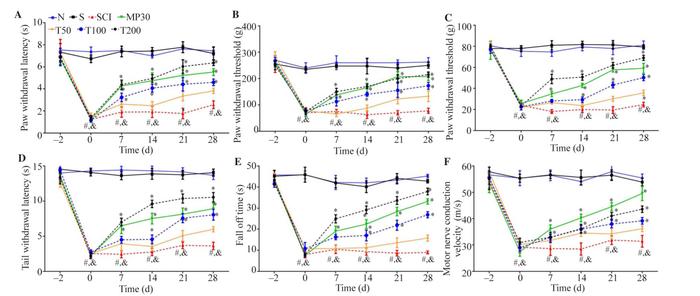In recent years, the quest for effective treatments for spinal cord injuries (SCI) has intensified, driven by the urgent need for novel therapies that promise enhanced recovery with fewer adverse effects. Among the contenders in this burgeoning field, trigonelline—a naturally occurring compound found in various plants—has emerged as a significant player, showcasing a potential neuroprotective effect against the ravages of SCI. This multifaceted compound is notably recognized for its role in modulating inflammation and apoptosis, making it a subject of keen interest among researchers.
In the realm of preclinical research, the evaluation of trigonelline’s therapeutic potential was exemplified through an experimental study that deployed a surgical aneurysm clip to induce SCI in a controlled rat model. Over a period of 28 days, male Sprague-Dawley rats were systematically assigned to one of seven treatment groups, including a control group, a sham group, and various trigonelline dosage groups. Each group comprised 15 rats, providing a robust sample size that facilitated statistical analysis of trigonelline’s effects against the backdrop of typical SCI-induced challenges.
The methodology adopted in this research was comprehensive, incorporating behavioral, biochemical, and histological assessments. The behavioral tests focused specifically on the evaluation of mechano-tactile sensation, allodynia, and hyperalgesia—parameters crucial for understanding the impact of SCI on sensory function. Moreover, motor nerve conduction velocity was meticulously measured to provide insights into the functional recovery of the injured spinal cord, augmenting our understanding of trigonelline’s efficacy.
Biochemically, the analysis revolved around profiling apoptotic and inflammatory markers within the spinal cord tissue. These biomarkers, including Bax, caspase-3, COX-Ⅱ, and Bcl-2, were scrutinized to evaluate the role of trigonelline in modulating key pathways associated with neuronal survival. Noteworthy findings revealed a significant downregulation of pro-apoptotic markers and COX-Ⅱ in the treatment groups receiving higher doses of trigonelline, a clear indication of its neuroprotective potential.
Furthermore, this study ventured into mitochondrial dynamics, unraveling the complexities of energy metabolism following traumatic injury. An alarming characteristic of SCI is the disruption of mitochondrial function, contributing to cellular energy deficits and increased apoptosis. Remarkably, trigonelline administration counteracted alterations in mitochondrial complex levels, thus preserving the energy homeostasis essential for recovery. Enhancements in parameters such as nicotinamide adenine dinucleotide dehydrogenase and succinate dehydrogenase levels testify to trigonelline’s role in supporting mitochondrial health in the aftermath of SCI.
Histological examinations of spinal cord tissue provided critical insights into the structural aspects of trigonelline’s protective properties. The morphological integrity of neuronal populations was notably preserved, with a marked reduction in necrosis and infiltrating inflammatory cells. The correlation between these histological findings and behavioral improvements strongly suggests that trigonelline’s neuroprotective mechanism is multifactorial, encompassing both cellular and molecular dimensions.
Moreover, the experimental design ensured rigorous scientific scrutiny, utilizing two-way ANOVA followed by Bonferroni’s multiple range test for post-hoc comparisons. This methodological rigor served to substantiate the statistical significance of the results, demonstrating that the therapeutic benefits of trigonelline were not merely coincidental but rather an outcome of its physiological action in the context of SCI.
As the study unfolded, the implications of trigonelline therapy extended beyond mere symptom relief. The research team posited that modified neuronal activity, potentially driven by the upregulation of neurotrophic factors such as BDNF, might also play a vital role in enhancing recovery post-injury. Such findings offer a novel avenue for exploration, prompting further investigation into the mechanistic pathways through which trigonelline exerts its beneficial effects.
In light of these promising outcomes, the discourse around trigonelline in the context of SCI exudes hope, particularly for those affected by this devastating condition. By addressing the challenges associated with existing treatment modalities, trigonelline stands as a beacon of potential within a therapeutic landscape that has been largely stagnant. Researchers advocate for advancing this area of study, proposing that more extensive trials in varied model systems may elucidate additional dimensions of trigonelline’s therapeutic arsenal.
In conclusion, trigonelline not only exhibits potential as a neuroprotective agent but also stimulates further inquiry into complementary and alternative strategies for managing SCI. Given the profound implications of its effects on inflammation, apoptosis, and neuronal recovery, trigonelline may ultimately provide a dual approach in tackling both the efficacy and safety profiles desirable in contemporary medicine. The evolving narrative surrounding this compound underscores the importance of innovative research pathways that aspire to unlock new treatment paradigms in the challenging domain of spinal cord injury recovery.
Understanding the broader scope of neurological recovery, trigonelline serves as a pertinent example of how naturally occurring substances may bring forth therapeutic breakthroughs. With a pressing need for improved outcomes in SCI management, the scientific community is urged to persist in exploring the multifaceted attributes of trigonelline and similar compounds, fostering an optimistically innovative trajectory toward neural health restoration.
—
Subject of Research: Animals
Article Title: Trigonelline exerts its neuroprotective effects in experimental spinal cord injury through modulation of inflammation, apoptosis, and neurotrophic factors
News Publication Date: 17-Jan-2025
Web References: Not available
References: Not available
Image Credits: Not available
Keywords: Neuroprotection, Spinal Cord Injury, Trigonelline, Inflammation, Apoptosis, Neurotrophic Factors, Mitochondrial Function.




